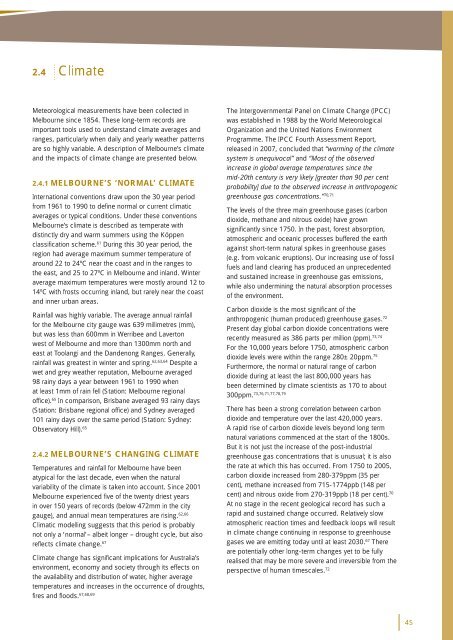Metropolitan Melbourne Investigation Discussion Paper - Victorian ...
Metropolitan Melbourne Investigation Discussion Paper - Victorian ...
Metropolitan Melbourne Investigation Discussion Paper - Victorian ...
Create successful ePaper yourself
Turn your PDF publications into a flip-book with our unique Google optimized e-Paper software.
2.4 Climate<br />
Meteorological measurements have been collected in<br />
<strong>Melbourne</strong> since 1854. These long-term records are<br />
important tools used to understand climate averages and<br />
ranges, particularly when daily and yearly weather patterns<br />
are so highly variable. A description of <strong>Melbourne</strong>’s climate<br />
and the impacts of climate change are presented below.<br />
2.4.1 MELBOURNE’S ‘NORMAL’ CLIMATE<br />
International conventions draw upon the 30 year period<br />
from 1961 to 1990 to defi ne normal or current climatic<br />
averages or typical conditions. Under these conventions<br />
<strong>Melbourne</strong>’s climate is described as temperate with<br />
distinctly dry and warm summers using the Köppen<br />
classifi cation scheme. 61 During this 30 year period, the<br />
region had average maximum summer temperature of<br />
around 22 to 24ºC near the coast and in the ranges to<br />
the east, and 25 to 27ºC in <strong>Melbourne</strong> and inland. Winter<br />
average maximum temperatures were mostly around 12 to<br />
14ºC with frosts occurring inland, but rarely near the coast<br />
and inner urban areas.<br />
Rainfall was highly variable. The average annual rainfall<br />
for the <strong>Melbourne</strong> city gauge was 639 millimetres (mm),<br />
but was less than 600mm in Werribee and Laverton<br />
west of <strong>Melbourne</strong> and more than 1300mm north and<br />
east at Toolangi and the Dandenong Ranges. Generally,<br />
rainfall was greatest in winter and spring. 62,63,64 Despite a<br />
wet and grey weather reputation, <strong>Melbourne</strong> averaged<br />
98 rainy days a year between 1961 to 1990 when<br />
at least 1mm of rain fell (Station: <strong>Melbourne</strong> regional<br />
offi ce). 65 In comparison, Brisbane averaged 93 rainy days<br />
(Station: Brisbane regional offi ce) and Sydney averaged<br />
101 rainy days over the same period (Station: Sydney:<br />
Observatory Hill). 65<br />
2.4.2 MELBOURNE’S CHANGING CLIMATE<br />
Temperatures and rainfall for <strong>Melbourne</strong> have been<br />
atypical for the last decade, even when the natural<br />
variability of the climate is taken into account. Since 2001<br />
<strong>Melbourne</strong> experienced fi ve of the twenty driest years<br />
in over 150 years of records (below 472mm in the city<br />
gauge), and annual mean temperatures are rising. 62,66<br />
Climatic modelling suggests that this period is probably<br />
not only a ‘normal’– albeit longer – drought cycle, but also<br />
refl ects climate change. 67<br />
Climate change has signifi cant implications for Australia’s<br />
environment, economy and society through its effects on<br />
the availability and distribution of water, higher average<br />
temperatures and increases in the occurrence of droughts,<br />
fi res and fl oods. 67,68,69<br />
The Intergovernmental Panel on Climate Change (IPCC)<br />
was established in 1988 by the World Meteorological<br />
Organization and the United Nations Environment<br />
Programme. The IPCC Fourth Assessment Report,<br />
released in 2007, concluded that “warming of the climate<br />
system is unequivocal” and “Most of the observed<br />
increase in global average temperatures since the<br />
mid-20th century is very likely [greater than 90 per cent<br />
probability] due to the observed increase in anthropogenic<br />
greenhouse gas concentrations.” 70,71<br />
The levels of the three main greenhouse gases (carbon<br />
dioxide, methane and nitrous oxide) have grown<br />
signifi cantly since 1750. In the past, forest absorption,<br />
atmospheric and oceanic processes buffered the earth<br />
against short-term natural spikes in greenhouse gases<br />
(e.g. from volcanic eruptions). Our increasing use of fossil<br />
fuels and land clearing has produced an unprecedented<br />
and sustained increase in greenhouse gas emissions,<br />
while also undermining the natural absorption processes<br />
of the environment.<br />
Carbon dioxide is the most signifi cant of the<br />
anthropogenic (human produced) greenhouse gases. 72<br />
Present day global carbon dioxide concentrations were<br />
recently measured as 386 parts per million (ppm). 73,74<br />
For the 10,000 years before 1750, atmospheric carbon<br />
dioxide levels were within the range 280± 20ppm. 75<br />
Furthermore, the normal or natural range of carbon<br />
dioxide during at least the last 800,000 years has<br />
been determined by climate scientists as 170 to about<br />
300ppm. 73,76,71,77,78,79<br />
There has been a strong correlation between carbon<br />
dioxide and temperature over the last 420,000 years.<br />
A rapid rise of carbon dioxide levels beyond long term<br />
natural variations commenced at the start of the 1800s.<br />
But it is not just the increase of the post-industrial<br />
greenhouse gas concentrations that is unusual; it is also<br />
the rate at which this has occurred. From 1750 to 2005,<br />
carbon dioxide increased from 280-379ppm (35 per<br />
cent), methane increased from 715-1774ppb (148 per<br />
cent) and nitrous oxide from 270-319ppb (18 per cent). 70<br />
At no stage in the recent geological record has such a<br />
rapid and sustained change occurred. Relatively slow<br />
atmospheric reaction times and feedback loops will result<br />
in climate change continuing in response to greenhouse<br />
gases we are emitting today until at least 2030. 67 There<br />
are potentially other long-term changes yet to be fully<br />
realised that may be more severe and irreversible from the<br />
perspective of human timescales. 72<br />
45
















